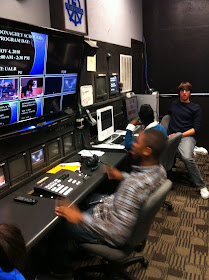After my long winded diatribe a couple days ago, I promised a follow up on what's so positive about my block 1 multimedia class, which has undergone a significant transformation in the past 5 weeks.
Right now there is nothing more authentic for my television news crew that producing a daily program. I honestly wish I had started a student news team 2 years ago when my class dabbled in it for 3 short episodes.
So, what is cool and totally awesome about the news?
1. Engagement. From the director to the anchor to the camera operator, all have work to do, and these jobs are VERY interdependent. If one person doesn't come through then many are affected. If a reporter doesn't have a story ready for the news by 9:15am then the script writer has to rewrite the script, the audio engineer needs to know that they don't have a package to adjust, the technical director has to change the settings in BoinxTV, and the graphics creator needs to change the lower thirds on the news. I've started a wiki to help support the development of the news (thanks Kaminski for this idea!). Students will write their own job description and as time goes on and their role changes they will make changes to it on the wiki. It's going to be my first 100% open and editable wiki, which is a big step for me. I'm trying to get the students to accept the idea of leaving something behind to help the next group do a better job next semester.
2. Real Deadlines, real audience. Real feedback. We get the best kind of feedback there is: peer feedback! Everyday the news is watched on our youtube channel by our teacher advisory classes. If our audio levels suck or a transition between stories isn't smooth we hear it. In addition to this we have partnered with Jim Billings' North Little Rock High TV program and their students are giving us advice and mentorship with our fledgling program.
3. Capitalizing on the strengths of each student.

Right now I have placed each student based on what I see as a fit for their own abilities and interests. What has happened is that students who are behind the camera want to stay in front of the camera. Since the anchors get all the glory, I'm seeing many reporters wanting to have their own crack at it. We now have 6 students who anchor in pairs. Next semester we will have tryouts for anchors, and with the advice and work of this semesters students, we will have the set job descriptions available to help each student.
So far so good. Life is great at RTV News. I think that RTV is now going to be a staple of life at Cold Lake High School, and I'm happy to say its been because of the task put before the students to do each day.
And yes, we have our own coffee mugs!!






























